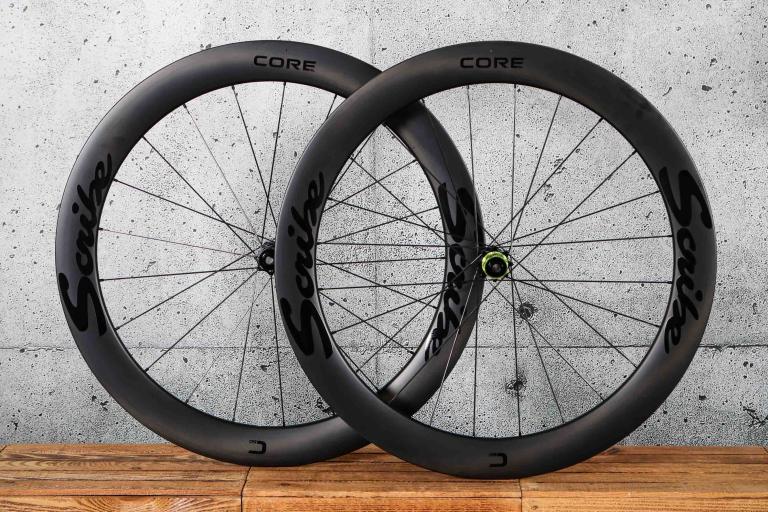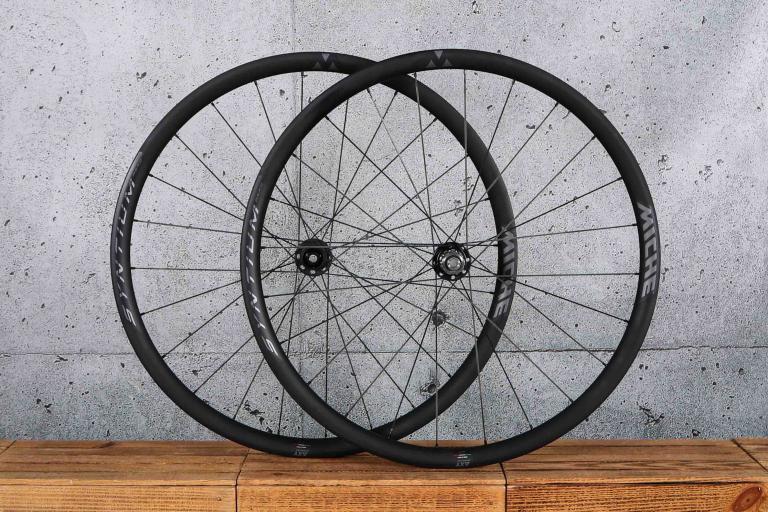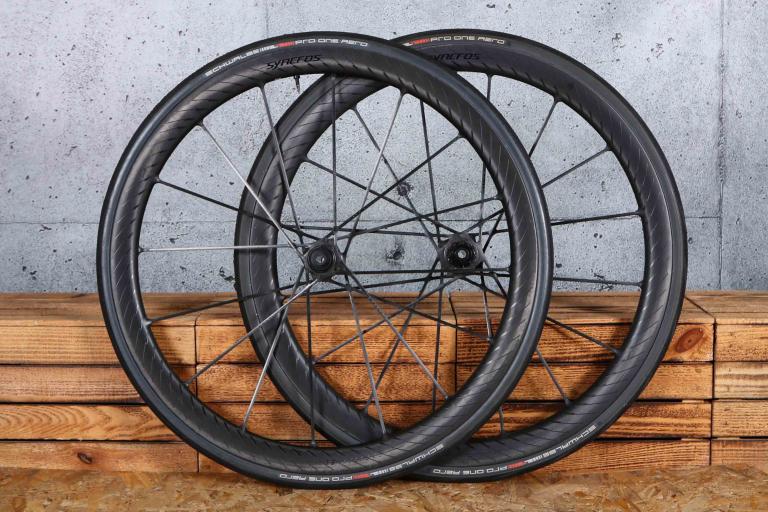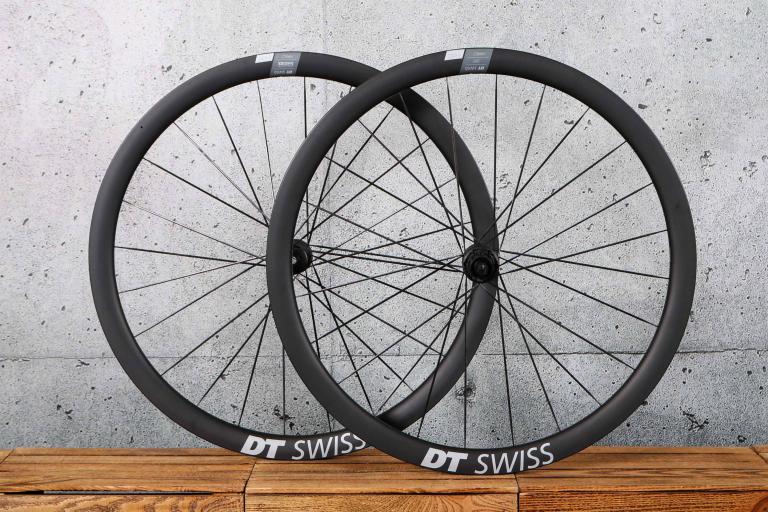- News
- Reviews
- Bikes
- Accessories
- Accessories - misc
- Computer mounts
- Bags
- Bar ends
- Bike bags & cases
- Bottle cages
- Bottles
- Cameras
- Car racks
- Child seats
- Computers
- Glasses
- GPS units
- Helmets
- Lights - front
- Lights - rear
- Lights - sets
- Locks
- Mirrors
- Mudguards
- Racks
- Pumps & CO2 inflators
- Puncture kits
- Reflectives
- Smart watches
- Stands and racks
- Trailers
- Clothing
- Components
- Bar tape & grips
- Bottom brackets
- Brake & gear cables
- Brake & STI levers
- Brake pads & spares
- Brakes
- Cassettes & freewheels
- Chains
- Chainsets & chainrings
- Derailleurs - front
- Derailleurs - rear
- Forks
- Gear levers & shifters
- Groupsets
- Handlebars & extensions
- Headsets
- Hubs
- Inner tubes
- Pedals
- Quick releases & skewers
- Saddles
- Seatposts
- Stems
- Wheels
- Tyres
- Health, fitness and nutrition
- Tools and workshop
- Miscellaneous
- Tubeless valves
- Buyers Guides
- Features
- Forum
- Recommends
- Podcast
review
£1,799.99
VERDICT:
Tough and fairly light mid-section wheels with some novel technologies
Weight:
1,450g
Contact:
www.chickencycles.co.uk
At road.cc every product is thoroughly tested for as long as it takes to get a proper insight into how well it works. Our reviewers are experienced cyclists that we trust to be objective. While we strive to ensure that opinions expressed are backed up by facts, reviews are by their nature an informed opinion, not a definitive verdict. We don't intentionally try to break anything (except locks) but we do try to look for weak points in any design. The overall score is not just an average of the other scores: it reflects both a product's function and value – with value determined by how a product compares with items of similar spec, quality, and price.
What the road.cc scores meanGood scores are more common than bad, because fortunately good products are more common than bad.
- Exceptional
- Excellent
- Very Good
- Good
- Quite good
- Average
- Not so good
- Poor
- Bad
- Appalling
Deda Elementi's catchily-named WD45CCL wheels are part of the Italian parts maker's first foray into carbon wheels which includes clinchers and tubular wheels in a couple of depths (30mm and 45mm) plus a cheaper aluminium 30mm set. Until now the Italian company has focused on finishing kit, offering the stems, bars and seatposts for which it is better known.
We've been testing the 45mm carbon clinchers, or WD45CCLs. Our wild guess is that the name decodes to: Wheels (by) Deda (of) 45 (mm depth) Carbon CLinchers. A mid-depth clincher set of respectable weight (1460g claimed, 1450g as measured on the road.cc scales of truth), the Dedas tick the usual boxes and offer a couple of more innovative tricks, as we'll see.
Out of the box, the wheels arrived straight and true, with even spoke tension. They're laced up with 2.2mm wide aero spokes, 18 radial at the front and 20 at the rear (one-cross on the drive side, radial non-drive). The wheels come with Elementi-branded aluminium external-cam skewers, which worked fine, plus - a nice touch - a good quality padded wheel bag. There are some spare spokes and you also get some Big Pads. We'll come back to them.
Now that every man and his dog can sell you a set of carbon racing wheels, you need more than a nice padded bag to justify spending the thick end of £2,000. You can get a set of Enve 45mm clinchers for a similar price to the Deda and Zipp's 303 clinchers (also 45mm deep) can be found online for not much more.
To Deda's credit they're touting a few interesting technological innovations here, so let's take a look at what's new and different.
Reverse Inertia Concept
Lost in translation perhaps, but I think Reduced Inertia Concept would probably be a little more apt. In short, the nipples are located on the hubs and not at the rim. The less weight you have at the rim, the faster a wheel will accelerate. Deda saved me the bother of taking the wheels apart to work out how much inertia has been 'reversed' - according to their website the nipples constitute 36.1 grams for the wheelset. This might not sound a lot but you could look at it as like switching to thinner inner tubes (without the associated increased risk of punctures).
High temperature resin
This is clearly a desirable attribute in a carbon wheelset - everyone's heard the horror stories of melty wheels - but just about every carbon wheelset I've tested has boasted of its superlative temperature resistance, so I guess they've cracked that problem. I am somewhat sceptical of companies who claim that their wheels 'get less hot' than the competition, what with braking being the simple conversion of kinetic to thermal energy, but Deda merely claim that they've tested theirs to almost 200°C without a problem. I had no issues at all with overheating (but it is winter and I don't live in the Alps).
The perfect pull
You might have been wondering 'so if the nipple is located at the hub, how does the other end of the spoke terminate in the rim?' and it's a good question. The answer, it turns out, is that there's a metal washer shaped to fit the inside of the rim, effectively captive on the end of the spoke. Coupled with the asymmetric drilling of the rim, this helps ensure that each spoke is loaded in pure tension, which should mean a stronger wheel and less likelihood of spoke breakage. The cynic in me can't help but point out that the weight of these metal washers must be offsetting at least some of that 'reverse inertia' benefit that we discussed earlier.
Wide brake track & Big Pads
One of the things immediately noticeable when you see these wheels is that the brake track is unusually wide - 16mm in fact. This is an interesting evolution from an earlier design - the 2012 version of these wheels featured a brake track located several millimetres inboard from the tyre, to 'produce less heat at the critical bead hook'. The advantage of this year's wider track is to allow you to use bigger brake pads, thus spreading the load (and heating effects) for reduced wear.
The Big Pad is quite a bit broader than a normal road pad, and therefore - like a man with one leg longer than the other - requires special shoes. Unfortunately neither Big Pads nor Big Shoes were in the box when it arrived for testing, so we can't comment on whether they make a difference in terms of brake feel, performance or wear. Instead we used the supplied carbon-specific blue brake pads.
The rims are 45mm deep and 21.5mm wide - very similar dimensions to the Enve 45s and significantly narrower than the Zipp 303s. Deda make no particularly specific claims about the aerodynamic advantage that these wheels might offer, aside from claiming 'maximum air penetration'.
During the test period, I used these wheels in racing, training and general fast road riding and found them to be about average for a mid-depth wheel in terms of speed. They slip through the air more easily than a shallow-section rim for sure, but I've ridden other (deeper, cheaper) wheels where the immediate gain in speed was more noticeable.
Where they certainly stood out was in terms of toughness and durability. The roads around here are in an abysmal state, but nothing that they could throw up caused any issues with the Dedas. In the notoriously skittish world of the Cat 4 criterium, I had the misfortune to be involved in two pretty unpleasant crashes (not my fault, guv, the guy in front went down etc and so on). The Dedas shrugged off the impact, not even needing truing - impressive. They are also amply stiff - no brake rub was evident at all during testing.
It's been mighty windy around here, and the Odd Down cycle circuit where I race is very exposed. Turning across the wind at speed you can feel the effect on the rims, but at 45mm deep and with the modern curved cross-section, they are not too much of a handful.
The rims are made of a combination of uni-directional and 3k carbon weave, with the brake tracks finished in the latter. This lends a slight texture, resulting in a noise like a rather quieter version of Mavic Exalith when braking. Brake performance was very good, in fact, even without the Big Pads. With the supplied blue brake pads, braking felt impressively strong and predictable in both wet and dry conditions.
The Reverse Inertia Concept obviously necessitates special hubs to accomodate the nipples, and these are extensively milled out to save weight. The rear hub in particular is quite an unusual looking thing. Deda's website has some nice engineering drawings of the cross section, if you're interested in such things.
Verdict
Deda's carbon clinchers are tough and fairly light mid-section wheels with some novel technologies. Braking is good for a full-carbon rim and they offer a reasonable (if not exceptional) aero benefit when compared to shallower wheels. At this price point there is some very established competition, but these would be a good bet if you'd like something a bit different.
road.cc test report
Make and model: Deda Elementi WD45CCL wheelset
Size tested: 45mm Black
Tell us what the product is for, and who it's aimed at. What do the manufacturers say about it? How does that compare to your own feelings about it?
Wheelset for high speed, maximum air penetration, extreme light weight and matchless style. Reverse Inertia concept.
Carbon fiber 45 mm deep profile rim, stainless steel elliptical black spokes, compact hub with double seal radial ball bearings.
Unique "Wide Brake Track" rim cross section, for maximum braking performance and rim stress relief.
Weight 1460 grams (front and rear, without quick release).
Meets and exceeds EN 14781 test standards. Also available for Campagnolo 11sp, Shimano 10s/11s and Sram cassette.
Tell us some more about the technical aspects of the product?
RIMS:
High-modulus carbon fibre UD and 3K combined structure, special formula resin, 3K brake surface, water transfer decals on matt finish, 45 mm high, for clincher (wire-on) tyres.
SPOKES:
straight pull head, stainless steel, aero profile 2,2 mm width, black.
NIPPLES:
Brass Cp, round head, 14G
HUB:
6061 aluminum alloy body, 18H front 20H rear, 6061 aluminum alloy axle 15 mm OD, 6 pawls freehub, available for Shimano/Sram or Campagnolo 11s.
BEARINGS:
Stainless-steel bearings, low friction seals, front:
(2) 24x15x5; rear: (2) 24x15x5 (1) 28x15x7.
QR:
Stainless-steel shaft, aluminum alloy 6061 lever, 56 g front, 60 g rear.
ACCESSORIES:
Black nylon wheel bag, 2x rim tapes, 4x brake pads Deda Blue, 4x brake shoes special design for oversized brake pad 'Big Pad'.
SPARE PARTS:
2x front spokes, 2x rear spokes.
Rate the product for quality of construction:
8/10
Well-built wheelset that can take a few knocks. Stayed perfectly true throughout the test period, which is impressive given a couple of bad "racing incidents".
Rate the product for performance:
7/10
I've not yet finished my wind tunnel, and Deda don't offer any scientific data on aero benefits. On the basis of subjective impressions over the review period, these offer a moderate but not exceptional aero benefit over non-aero wheels. I think there are faster wheels out there.
Rate the product for durability:
9/10
No issues during the test period.
Rate the product for weight, if applicable:
8/10
Weight is respectable if not outstanding for the rim profile. Enve 45s are pretty similar, Zipps 303s are a bit lighter.
Rate the product for comfort, if applicable:
5/10
I don't think a wheelset makes a notable contribution here.
Rate the product for value:
5/10
At £1800 Deda is up against wheelsets from Enve and Zipp, towards the top of the market. You can get a set of Reynolds Assault 46mm clinchers for almost half the price.
Tell us what you particularly liked about the product
Decent brake performance and excellent ruggedness. Wheel bag is a nice touch.
Tell us what you particularly disliked about the product
I wasn't overwhelmed by how fast these wheels felt compared to other aero wheelsets.
Did you enjoy using the product? Yes.
Would you consider buying the product? I'd probably be more tempted by something a bit less spendy.
Would you recommend the product to a friend? Maybe.
About the tester
Age: 35 Height: 6 Weight: 78kg
I usually ride: Boardman CX team for the daily commute My best bike is: Rose Xeon CRS
I've been riding for: Over 20 years I ride: Most days I would class myself as: Expert
I regularly do the following types of riding: road racing, time trialling, commuting, touring, club rides, sportives, general fitness riding, fixed/singlespeed, mtb,
Jez spends his days making robots that drive cars but is happiest when on two wheels. His roots are in mountain biking but he spends more time nowadays on the road, occasionally racing but more often just riding.
Latest Comments
- Mr Blackbird 4 min 5 sec ago
In defence of the suv driver, he was probably angered by the fact that the ebike didn't have numberplates. He may have been implementing the...
- Dougal McFougal 4 min 17 sec ago
Lived, worked and cycled in both Denmark and Netherlands so don't need to look at your google search results. Thanks though. Was actually a bit of...
- Bill H 11 min 45 sec ago
Any budding business tycoons amongst the peloton will do well to watch how Millar emerges from the wreckage compared to Wiggins. I am confident...
- Big Bleu 14 min 55 sec ago
From the DC Rainmaker review, it's clearly not a finished product, look back in 12 months and will no doubt be solid. No idea why it still needs...
- hawkinspeter 26 min 31 sec ago
Surely it is as it would count as opening the door recklessly (i.e. without checking that it was safe to do so) and thus would count as assault or...
- ChasP 1 hour 19 min ago
I've got the basic 100 version which meets my needs for a low constant setting with long battery life for overnight group rides. I find the mount...
- David9694 1 hour 43 min ago
Application to turn the former site of The Farmers pub in Sevenoaks into a six-storey, 56-apartment complex with three parking spaces...
- Rendel Harris 1 hour 44 min ago
Not just other riders either, journalists who dared to question him, support staff and others. What I found particularly despicable (and I...
- Oldfatgit 1 hour 50 min ago
How the feck can it be legal to drive a large PSV at 75 years old?
- Rendel Harris 2 hours 18 min ago
Absolutely not a victim blaming – the blame lies 100% with the driver of the truck – but I've been stuck in that position too many times in London,...














Add new comment
5 comments
You're paying for the R&D costs aren't you. You could well go and get some tried and tested off the peg hubs, spokes and rims then put them together for much less money, but if you want a complete wheel manufacturer to test how few spokes they can safely get away with, whether you can move the nipples to the hubs, how thin the rim material can be, if some new resin compound is going to kill you or not etc etc then you have to pay for it.
That and the opportunistic profiteering of course.
Love the idea of Adrian Newey designing bike products, could see some very interesting designs, maybe some channels or vents for air to flow through frames/wheels etc rather than just around it. I'd be tempted to spend that sort of money on wheels then.
Call me an old fart but I still can't get my head round how 1800 is the 'normal' price for wheels, in that wheels of that price aren't some sort of skunkworks product designed by Adrian Newey and Chris King and made out of moon rock and unobtanium, but just normal wheels.
Yeah, the ones on the drive-side spokes would be quite fiddly. You'd probably need a spanner-style spoke-wrench.
Those hub nipples look like they could potentially be an absolute nightmare if you ever need to tighten one.